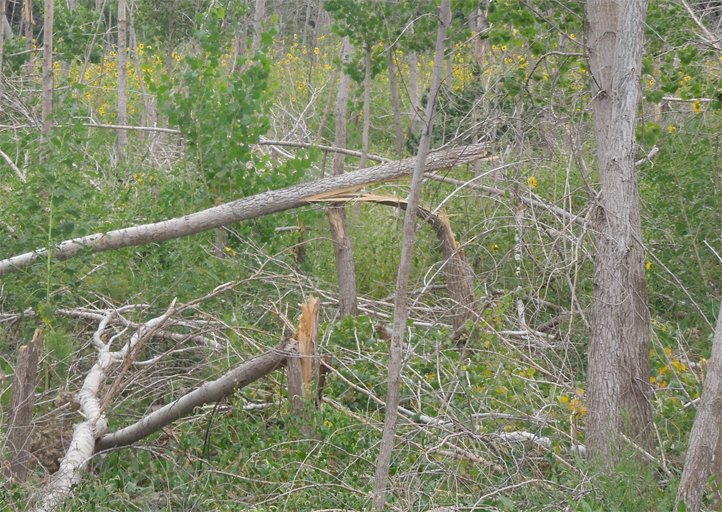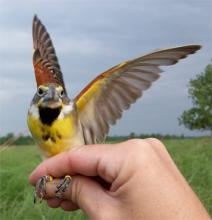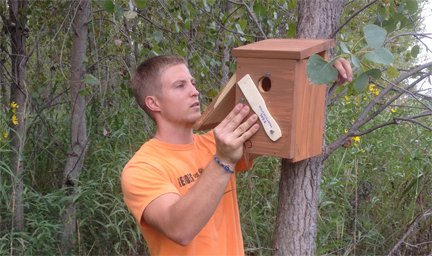Biology - Research and Discovery
All of our departmental faculty are committed to the idea that the only way to learn science is to “do science”. This collaborative, experience driven approach has been institutionalized at Benedictine College in the Discovery Program, which regularly provides annual grant support for over forty student/faculty research projects across the academic disciplines. Biology faculty regularly contribute to the Discovery Program with guided research projects that are constructed to provide students with needed opportunities to step outside of the classroom and apply what they have learned. Through the years, these experiences and additional, practical skill sets have proven to be extremely valuable as our students move on to medical schools, graduate programs, and employment. Any of our majors that wish to pursue research at Benedictine will be given the opportunity.
Active Research Projects
Benedictine College Herbarium Digitization

The Benedictine College H.W. Blocker Herbarium is a small, regional herbarium that houses approximately 7000 preserved plant specimens, some of which date back to the late 19th century. This collection currently provides a rich, but unknown resource to researchers across the country. In order to facilitate the use of preserved specimens to address research questions relating to climate change, species distribution, human alteration of ecosystems, and others topics, we are working to digitize our collection. We currently contribute to the Consortium of Northern Great Plains Herbaria, which makes our collection searchable and available to researchers globally. Current efforts are focused on completion of data entry for all specimens in our collection. Additional projects are underway to build and utilize a photo-box to capture digital images of each specimen and to use geolocation software to geo-reference each entry and image. Learn more
Carletti
Esophageal Cancer
As obesity rates climb in the United States, so does the incidence of gastroesophageal reflux disease (GERD). Due to an increase in inflammation in the esophagus from gastric acid exposure, GERD is a risk factor for Barrett's Esophagus (BE), the pre-malignant precursor of esophageal cancer. Esophageal cancer is one of the deadliest cancers – over 80% of those diagnosed will die within one year. As the incidence of BE and esophageal cancer rise (600% since 1975), the ability to prevent, diagnose, and treat BE is of utmost importance. Previous research has focused on the molecular mechanisms behind the progression of BE to malignant esophageal cancer. I propose to study the difference in molecular events in the GERD esophagus versus the BE, as understanding the reasons why 10-15% of GERD patients develop BE will allow for the identification of diagnostic markers, preventive measures, and potential treatments.
The transition from GERD to BE is characterized by the conversion of normal stratified squamous epithelial cells to columnar epithelial cells. Since numerous studies indicate microRNA (miRNA) mediate metaplasia events, we hypothesize they are also involved in the GERD to BE transition. MicroRNA are small non-coding RNA that target specific messenger RNA (mRNA) for translational repression or degradation. One miRNA can target hundreds of distinct mRNA, and therefore miRNA have the ability to drastically affect the proteome, and thus the phenotype, of the cell. MicroRNA have been used as diagnostic tools for cancer and miRNA have been used both in the prevention and treatment of cancer.
Recently, a number of miRNA were identified as differentially expressed between GERD and BE patients, but the distinct roles of these miRNA have not been assessed. In vitro analysis will allow for the verification of these miRNA, as well as the further characterization of their role in the GERD to BE transition.
This project will be done in collaboration with Dr. Lane K. Christenson at the University of Kansas Medical Center, Kansas City, KS and Dr.Ajay Bansel at the Veterans Affair Medical Center, Kansas City, KS.
Malloy
2011 Missouri Flood Impact

With support from the Corps of Engineers, my students and I are currently working with Dr. Mark Dixon at the University of South Dakota to assess the impacts of the 2011 flood on the riparian plant communities along segment 13 of the Missouri River. Students on this project have been trained to collect vegetation data using quadrat, line-intercept, and point-quarter methodology.
Students have also learned plant identification strategies, voucher specimen preparation, and database management and analysis tools. My research at Benedictine is constructed with the view that our students need opportunities to step outside of the classroom to apply what they have learned and develop additional, practical skill sets. Through the years, these experiences have proven to be extremely valuable as our students move into medical schools, graduate programs, and employment. Any of our majors that wish to pursue research at Benedictine will be given the opportunity.
Schramp
We are studying how epithelial cells adopt specific characteristics that allow them to function within an organ system. Epithelial cells line the exterior of most organs and are therefore essential for development and normal homeostasis. During development of an organ, cells must respond to signals that direct them to alter their behavior (i.e. movement/migration, division and differentiation). How a cell integrates and responds to these signals is essential to form a functional organ. In our lab, we use the model organism Caenorhabditis elegans to study how specific proteins regulate epithelial cell behavior during development. In particular, we are interested in how epithelial cells adhere to one another and to different protein matrices in their environment and how these connections are regulated during normal organogenesis. We have identified a number of important proteins (including the putative tumor suppressor protein, TES-1) that help epithelial cells move, form strong adhesions with other cells and their environment and adopt unique shapes that allow them to function within an organ. Our research can not only lead us to a deeper understanding of development, but can also shed light on how specific diseases arise. For instance, tumors that arise from epithelial cells constitute over 80% of the malignancies diagnosed each year. The ability of a tumor to form metastases, secondary tumors that enhance the lethality of the disease, depends on the same protein machinery that regulates normal cellular movement, migration and adhesion.
Winder
Songbirds on the Benedictine Bottoms

I used mist nets and conspecific call playback to target capture Common Yellowthroats and Dickcissels during the summer of 2014. I used combinations of color and metal bands to uniquely mark each individual, and I also weighed and measured each individual and took blood and feather samples. Continuing this banding effort in future years will allow me to collect data on site fidelity and demographic parameters such as survival, reproductive effort, and reproductive success. These parameters can be linked to habitat management activities to better manage for sensitive grassland or wetland species. Blood and feather samples will allow me to address questions about disease, metabolism, exposure to pollutants, or genetics. Similar to the nest box project, this ongoing banding study will include many opportunities for undergraduates to gain valuable field experience handling and monitoring wild birds.
Nest boxes

Over the summer of 2014, I worked with the Kansas Department of Wildlife, Parks & Tourism to build 50 nest boxes for migratory bird species on the Benedictine Bottoms Wildlife Area. These nest boxes were installed in several transects at various locations across the ~2,000-acre property. I expect Tree Swallows, Eastern Bluebirds, and Carolina Wrens to use the new boxes as early as next spring. With the help of students, I will be monitoring nest box use, nest success, and predator activity in different habitats to enhance mitigation recommendations. The nest boxes will allow us to closely monitor reproductive effort and success as well as to band adults and fledglings. Data collected from this project will help provide demographic estimates of hatchling, fledgling, juvenile, and adult survival. This research will also provide a great way for undergraduates to be involved in a long-term field study and gain experience collecting field data as well as capturing, handling, and banding wild birds.
Prairie-chickens
I am currently collaborating with researchers at Kansas State University on two projects that are addressing questions about the affect of wind energy development and fire and grazing management techniques on Greater Prairie-Chicken populations in northcentral Kansas. We use radio telemetry to track female prairie-chickens and monitor their nests, broods, and individual survival. We will use this information to address questions about population level demographic rates and trends as well as individual and population level space use in response to different anthropogenic and environmental variables (e.g., distance to road, frequency of fire, grazing intensity, distance to wind turbine, etc.). These projects will help provide novel insights into the spatial and population ecology of a species of conservation and economic concern in our area. Greater Prairie-Chickens have been identified as an umbrella species for tallgrass prairie ecosystems. This means, in theory, that if we can provide good quality habitat and breeding conditions for this species, that those management efforts will also benefit other types of wildlife in tallgrass prairies.
Recent Discovery Projects
Project Title: Humulus japonicus: A Non-Native Threat to Allergy Sufferers?
Investigators: John Thomas, Anastasia Ratcliff
Date: 2015
Project Title: Seed Dormancy and Germination of Japanese hop (Humulus japonicus): A Cold Case
Investigators: Natalie Cook, Terry Malloy, Virginia Winder, and Travis Almquist
Date: 2015
Project Title: Recycling at Benedictine
Investigators: Emily Dyer, Travis Almquist, and Virginia Winder
Date: 2015
Project Title: Examining Small Mammal Populations, Diversity, and Survivorship on the Benedictine Bottoms
Investigators: Michael Collins, Mary Miller, Joseph Schmit, Travis Almquist, Terry Malloy, Virginia Winder
Date: 2015
Project Title: The development of germination protocols in a lab setting on Humulus japonicus (Japanese hops)
Investigators: Kelley McVeigh and Travis Almquist
Date: 2014
Project Title: The Benedictine College Herbarium: Assessing an Unused Botanical Resource
Investigators: Madison Zubradt and Travis Almquist
Date: 2014
Project Title: Surveying Bird Biodiversity and Creating a GIS Map of Benedictine Bottoms
Investigators: Mary Miller and Virginia Winder
Date: 2014
Project Title: Crow and Raptor Surveys of the Benedictine Bottoms
Investigators: Joseph Schmit and Virginia Winder
Date: 2014
Project Title: Expression pattern and sub-cellular localization of TES-1 and UNC-34 during epithelial morphogenesis
Investigators: Kevin Amthor, Nick Loughman, Mark Schramp
Date: 2014
Project Title: Effects of TES-1 and UNC-34 proteins on the Behavior of Epithelial Cells
Investigators: Rachel Foguth, Mark Schramp
Date: 2014
Project Title: Identifying LIM-domain proteins that regulate epithelial morphogenesis in C. elegans
Investigators: Brennan Roche, Mark Schramp
Date: 2014
Project Title: Pre- and Post-Flood Species Richness of Herbaceous Vegetation Along Segment 13 of the Missouri River
Investigators: Jordan Campbell, Aaron Halling, Mary Ellen Ostrowski, Gregory Frederick, Travis Almquist, Terry Malloy
Date: 2014
Project Title: A Comparison of Fish Species Richness and Relative Abundance Between Whitewater and Blackwater Habitats on the Tamshiyacu-Tahuayo Reserve, Peru
Investigators: Natalie Cook, Rachel Hernandez, Virginia Winder, Travis Almquist, Terry Malloy
Date: 2014
Project Title: Exploring the Toxicity of Cottonmouth Venom
Investigators: Bienvenido Cortes, Jeremy Ambrose, John Corkum, Mary Bridget Pecha, Laura Tibbs, Lawrence Bradford, OSB, Terry Malloy
Date: 2014
Project Title: Amphibian Diversity and Microhabitat Use Along the Tahuayo River, Loreto District, Peru
Investigators: Rachel Hernandez, Virginia Winder, Travis Almquist, Terry Malloy
Date: 2014
Project Title: Flood Related Density and Mortality Changes to Riparian Forests of Segment 13 of the Missouri River Floodplain
Investigators: Mary Ellen Ostrowski, Gregory Frederick, Jordan Campbell, Aaron Halling, Travis Almquist, Terry Malloy
Date: 2014
Project Title: Avian Community Stratification Within Forest Layers in the Amazon River Basin
Investigators: Margaret Schuh, Virginia Winder, Terry Malloy, Travis Almquist
Date: 2014

